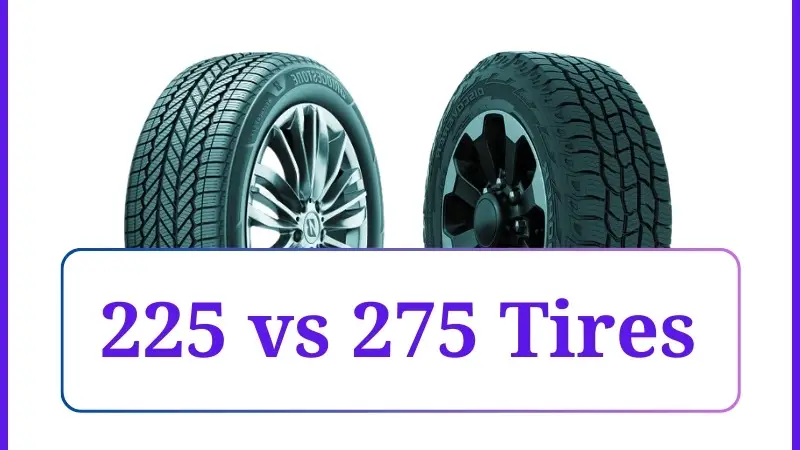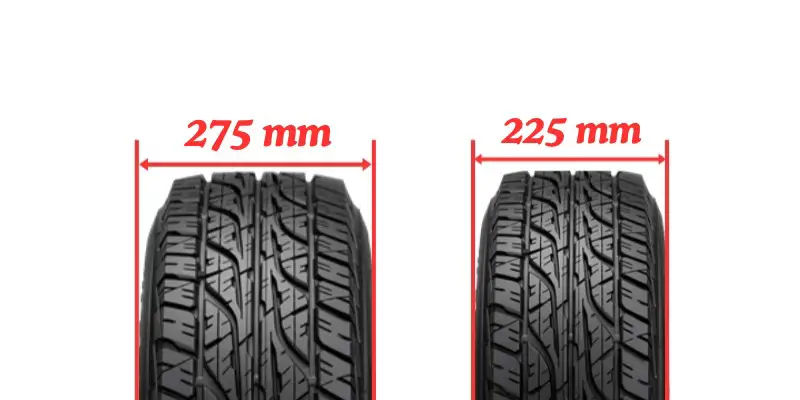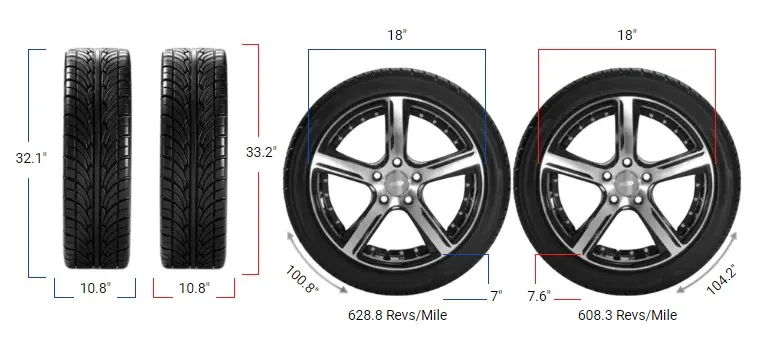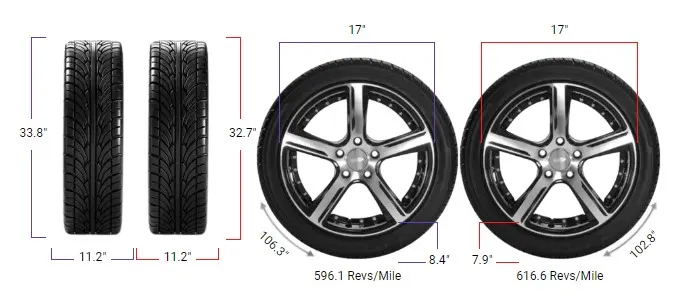225 vs 275 Tires

The main difference between 225 and 275 tires is their width. The 275 tires is about 50 mm wider than the 225 tires. The 225 tire is 225 millimeters wide, whereas the 275 tire measures 275 millimeters in width.
This 50 mm difference significantly affects how the tire interacts with the road and impacts several aspects of vehicle performance, such as traction, stability, and fuel efficiency.
A 275 tire, with its wider footprint, provides a larger contact patch compared to a 225 tire. This increased contact area helps to improve traction, particularly in dry conditions, and can enhance cornering stability, making it ideal for those who prioritize high-speed performance or spirited driving.
However, this increased width also means more rolling resistance, which can reduce fuel efficiency and impact your vehicle’s economy.
On the other hand, 225 tires have a smaller contact patch, leading to lower rolling resistance and improved fuel efficiency. This can be a deciding factor for daily commuters or those who frequently drive long distances and want to maximize fuel savings.
Additionally, the narrower 225 tire can offer lighter steering, making it easier to handle, especially in city driving scenarios.

Fitment Guide
It’s important to ensure proper fitment for safety and performance. Here, the Ideal Rim Width Range Guide comes into play. Let’s take a closer look:
- The 225 tire is best suited for rims ranging from 7.0 to 8.0 inches in width.
- The 275 tire fits rims between 9.0 to 10.0 inches in width.
The ideal rim width range must overlap. Since 225 and 275 tires do not share an overlapping rim width range, switching from 225 to 275 tires will require new rims that fit the 275 tire specifications.
On-Road Impact
The choice between 225 and 275 tires has a noticeable impact on how your vehicle performs on the road:
- Handling and Stability: With 275 tires, you get more lateral grip because of the larger contact area. This makes the car feel more stable when cornering, especially at higher speeds. If you enjoy taking winding roads or pushing your vehicle’s limits, 275 tires are likely to give you that extra edge.
- Fuel Efficiency: 225 tires offer less rolling resistance compared to 275 tires, meaning the engine has to work less to keep the car moving. This leads to better fuel efficiency, especially for highway driving. For drivers who put a premium on fuel savings, 225 tires are a smart choice.
- Comfort: Wider 275 tires can often provide a smoother ride since the larger contact patch helps to absorb road imperfections better. However, they may also create more road noise compared to 225 tires. The narrower 225 tire may produce less noise, which can contribute to a quieter and more comfortable ride in daily driving scenarios.

Off-Road Impact
If you like to take your vehicle off the beaten path, the difference between 225 and 275 tires can also play a role in how well your car handles rough terrain:
- Traction on Loose Surfaces: 275 tires have a larger footprint, which helps distribute the vehicle’s weight more evenly and provides better traction on loose surfaces like sand, mud, or gravel. This makes 275 tires an excellent choice for off-road enthusiasts looking for extra stability.
- Maneuverability: On the other hand, 225 tires are more maneuverable on tighter trails or rocky paths. The narrower width allows for easier navigation through narrow spaces and gives the vehicle better precision when tackling challenging terrain.
Speedometer Impact
Changing from 225 to 275 tires can also impact your vehicle’s speedometer and odometer readings. The overall diameter of the tire may increase or decrease depending on the sidewall height, which can cause discrepancies in the speedometer reading.
For example, if the 275 tire has a larger diameter than the 225 tire, your speedometer may show a speed that is slower than your actual speed.
To maintain accurate speed and distance measurements, it may be necessary to recalibrate the speedometer after switching tire sizes. This is especially important if the diameter difference is greater than the recommended 3% threshold.

Benefits of 275 Tires:
- Enhanced Traction and Stability: The wider footprint provides improved traction, especially in dry conditions, and better stability during high-speed driving and cornering.
- Off-Road Capability: 275 tires excel in off-road environments, providing better flotation and grip on loose surfaces.
- Aggressive Look: The wider stance of 275 tires gives the vehicle a more rugged and sporty appearance, which is appealing to many drivers.
Drawbacks of 275 Tires:
- Lower Fuel Efficiency: The increased rolling resistance of 275 tires can lead to lower fuel economy, particularly in city driving.
- Potential Fitment Issues: Switching to 275 tires may require new rims, and there could be clearance issues with your vehicle’s wheel wells.
Benefits of 225 Tires:
- Better Fuel Economy: The narrower profile means less rolling resistance, translating to improved fuel efficiency, which is ideal for long commutes.
- Maneuverability: 225 tires make the vehicle easier to handle, especially in tight city spaces where quick maneuvers are needed.
- Quieter Ride: With less road contact, 225 tires tend to generate less road noise, making for a quieter and more comfortable ride on highways.
Drawbacks of 225 Tires:
- Reduced Traction: Compared to 275 tires, the 225 tires have a smaller contact patch, which can lead to reduced traction, particularly in high-speed cornering or wet conditions.
- Less Aggressive Look: The narrower width of 225 tires may not provide the bold, aggressive stance that some drivers prefer.

Difference Between 225 and 275 Tires
The main difference between 225 and 275 tires is the width. 275 tires are 50mm wider than 225 tires, affecting stability, handling, and overall vehicle performance. Wider tires generally provide better traction but can impact fuel efficiency.
Can I Use 225 Tires Instead of 275?
Using 225 tires instead of 275 is not recommended because their ideal rim width ranges do not overlap. A 225 tire fits rims between 6.5 and 8.0 inches, while a 275 tire requires rims between 8.5 and 10.0 inches. Swapping to a narrower tire on a wider rim can lead to improper fit and safety issues.
Can I Use 275 Tires Instead of 225?
It’s generally unsafe to use 275 tires instead of 225 tires. The 275 tires need rims that are 8.5 to 10.0 inches wide, whereas 225 tires fit rims that are 6.5 to 8.0 inches wide. Installing wider tires on narrower rims can cause mounting problems and compromise vehicle handling and safety.
Can You Put 225 Tires on 275 Rims?
No, you should not put 225 tires on rims designed for 275 tires. The 225 tires are suitable for rim widths of 6.5 to 8.0 inches, while 275 rims are 8.5 to 10.0 inches wide. Using a narrower tire on a wider rim can result in poor tire seating and increased risk of tire failure.
Can You Put 275 Tires on 225 Rims?
No, installing 275 tires on rims intended for 225 tires is inadvisable. The 275 tires require rim widths between 8.5 and 10.0 inches, but 225 rims are only 6.5 to 8.0 inches wide. Mounting wider tires on narrower rims can lead to sidewall stress and potential tire blowouts, posing safety hazards.
How will switching to 275 tires affect my fuel efficiency?
275 tires have more rolling resistance, which can reduce fuel efficiency compared to 225 tires.
Will 275 tires improve my vehicle’s off-road performance?
Yes, 275 tires provide a larger contact patch, which enhances traction and stability on loose surfaces like gravel and mud.
Do I need to recalibrate my speedometer if I switch from 225 to 275 tires?
If the overall diameter changes by more than 3%, recalibration may be necessary to maintain accurate speedometer and odometer readings.
Our Observation
Based on our observation, the switching from 225 tires to 275 tore in not recommended. If you still want you switch then the lift kit should be needed to proper fitment. The choice between 225 and 275 tires ultimately depends on your driving needs and preferences.
If you value fuel efficiency, maneuverability, and a quieter ride, 225 tires are likely the best fit. However, if you want enhanced stability, better off-road performance, and a more aggressive look, then 275 tires are the way to go.
Always remember to consider rim compatibility and overall diameter differences to ensure a safe and effective switch.



